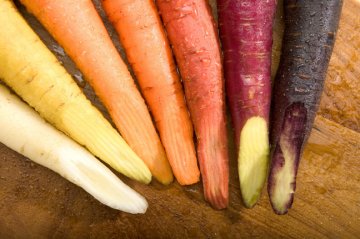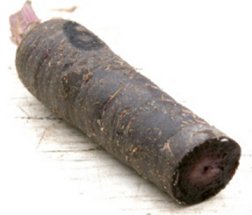A Carrot Rainbow (with recipe)
Thanksgiving menus typically include root vegetables. Although some of those vegetables can be slightly exotic—from kohlrabi and rutabaga to ginger—many are familiar standbys, such as carrots. Long, fat, and orange, they make good snacks, add moisture to cakes, and sometimes serve as the nose on a snowman’s face.




Orange was not the carrot’s original tint, however. A native of western Asia, this cool-season member of the parsley family started out in various shades of white, yellow, and purple. It took on orange shades only under the hand of 16th century Dutch horticulturalists, according to researchers with the U.S. Department of Agriculture’s Economic Research Service.
In recent years, other USDA scientists have enhanced the now-familiar orange carrots by breeding lines with elevated concentrations of the pigment beta-carotene—a material from which the body fashions vitamin A. The result: Most U.S. carrots now offer about 75 percent more beta-carotene than they did 25 years ago.
However, plant geneticist Philipp Simon and his carrot-breeding colleagues at USDA’s Vegetable Crops Research Unit in Madison, Wis., didn’t stop there. They’ve been breeding carrots in a rainbow of antique hues, including red and deep purple, to survive in U.S. soils and appeal to American flavor preferences.
Red carrots have proven a particular challenge. Many haven’t proven too tasty without heavy cooking—a problem since the vast majority of U.S. carrots is eaten raw. Most imported red carrots, from Asia, fall prey to the root-rot fungus Sclerotium rolfsii that’s present in most U.S. soils. “Nobody even knows how to control it, from the standpoint of fungicides,” Simon says, “because it so seldom affects typical U.S. carrots.” Indeed, he notes, domestic veggies that might have been vulnerable would have been culled over the decades.
Another problem with imported Asian varieties of carrots is that when grown in the United States they have a tendency to bolt—send up flowers—earlier than in Japan or China. Not only does flowering shut down root growth—and carrots are the roots of these plants—but it also turns the root woody. The would-be vegetables quickly turn “tough to the point that you can’t cut through them with a knife,” says Simon.
The Madison geneticists have been working around the problem by crossbreeding carrots of the same color from disparate parts of the world. For instance, Simon says, “we’ve intercrossed purple carrots from Lebanon, Syria, and Turkey.” Similarly, they’ve crossbred reds from Japan, Korea, and China. Sometimes, the resulting hybrids will also be crossed again with some orange carrots to introduce genes for flavor, disease resistance, or climate hardiness.
Tailoring the nonorange carrots for U.S. production has proven an uphill battle, Simon acknowledges, but many successful products have been released to commercial growers over the past decade. These usually require a little more crossbreeding or selection to find the right carrot for local climate and soil conditions. Simon’s lab has dozens more “Technicolor” carrots to be rolled out in the next few years.
Colorful benefits
Although these novel varieties can make for colorful salads, the motivation behind their development wasn’t aesthetics. It was to improve domestic orange cultivars that his team initially began importing hosts of foreign reds, whites, and blues some quarter-century ago.
However, as data emerged about health benefits associated with pigments in vegetables, Simon’s group began turning their attention to developing non-orange carrots for domestic consumption.
The richly hued cultivars, in particular, offer a bounty of carotenoids and anthocyanins. Dozens of studies have linked these pigmented compounds, which are also antioxidants, with a host of benefits. They apparently can reduce heart disease, certain cancers, a type of blinding eye disorder, memory loss, and even sunburn.
Of course, such benefits would accrue only if the body actually acquired substantial quantities of the pigment from a food—which isn’t a given. Some abundant nutrients in plants foods remain largely unavailable to the body because of the substance’s chemical or physical form in the plant. That’s why Simon’s team has been testing the bioavailability of carrot pigments. The good news: Recent studies confirm that carrots readily give up their nutritious antioxidants to people eating the vegetable.
Want to grow some of these vibrant carrots in your backyard? Simon’s lab has compiled a list of commercial seed sources (http://www.ars.usda.gov/Research/docs.htm?docid=5236). Some offer cultivars that owe much of their heritage to USDA’s breeding efforts. Others derive from independent growers who imported and tinkered with foreign carrots on their own.
The good news for those adventurous enough to try these nontraditional varieties is that their color bears no relation to their flavor. All taste like, well, carrots. Personally, I can’t wait to try them in my most-requested recipe (below).
Janet’s Carrot Salad
This can be hot or not, depending on the inclusion of a little Tabasco. Adults tend to appreciate the unexpected kick, kids don’t.
For each pound of peeled and grated carrots, mix in at least (I tend to be a little heavy-handed with the condiments):
- 1/2 to 1 cup dried parsley
- 8 tbs. dried mint (or a half cup of freshly minced leaves—keep the stems out)
- 6 to 8 tbs. garlic powder
- 6 to 8 tbs. powdered cumin
- Salt and freshly ground black pepper (to taste)
Now add olive or canola oil (canola has less saturated fat), about 1/3 cup. Also add at least 1/4 cup of lemon juice. Stir again.
It tastes best when prepared an hour ahead of time and left for the flavors to meld at room temperature. It will keep for 5 days in the refrigerator.







